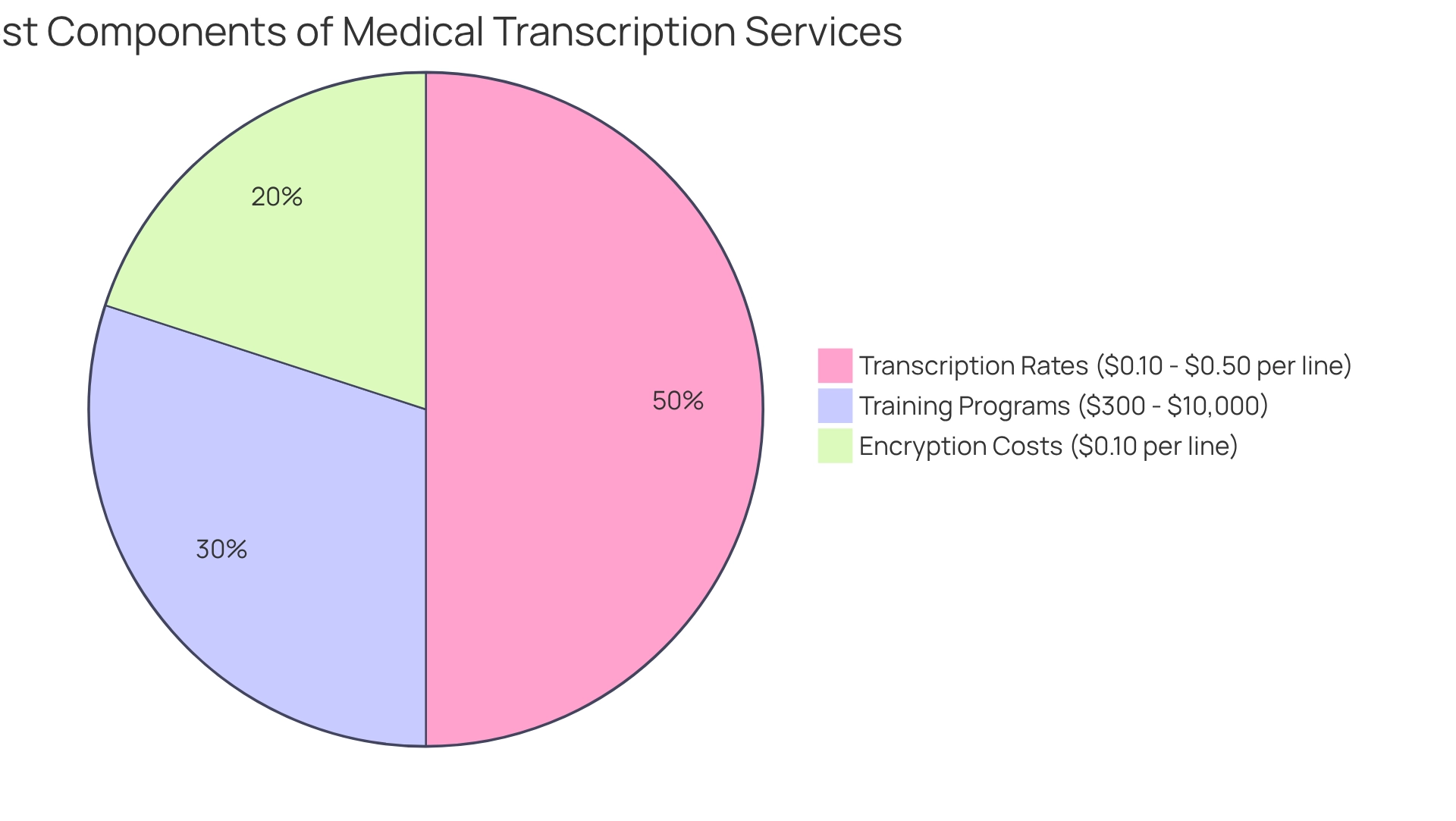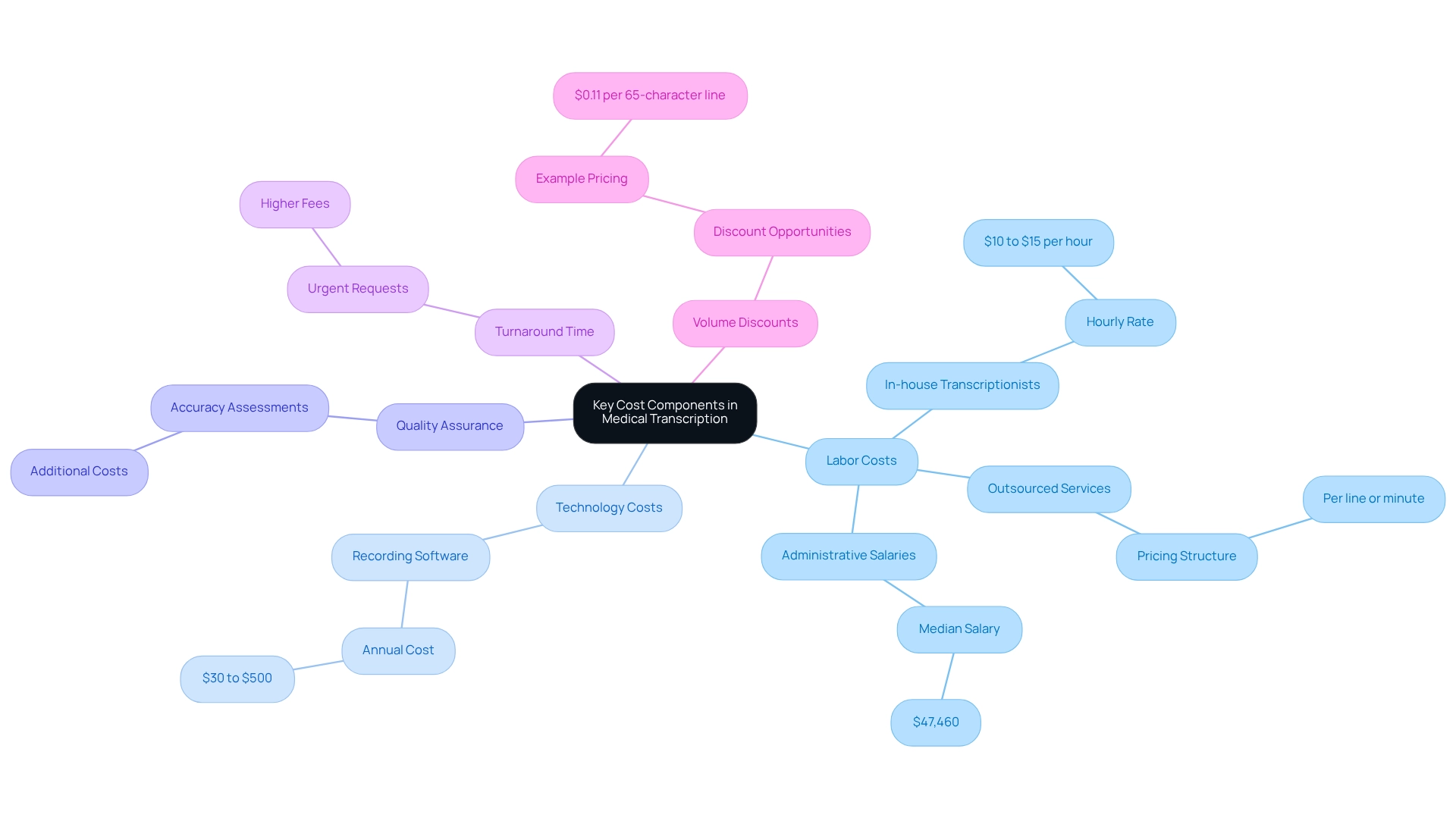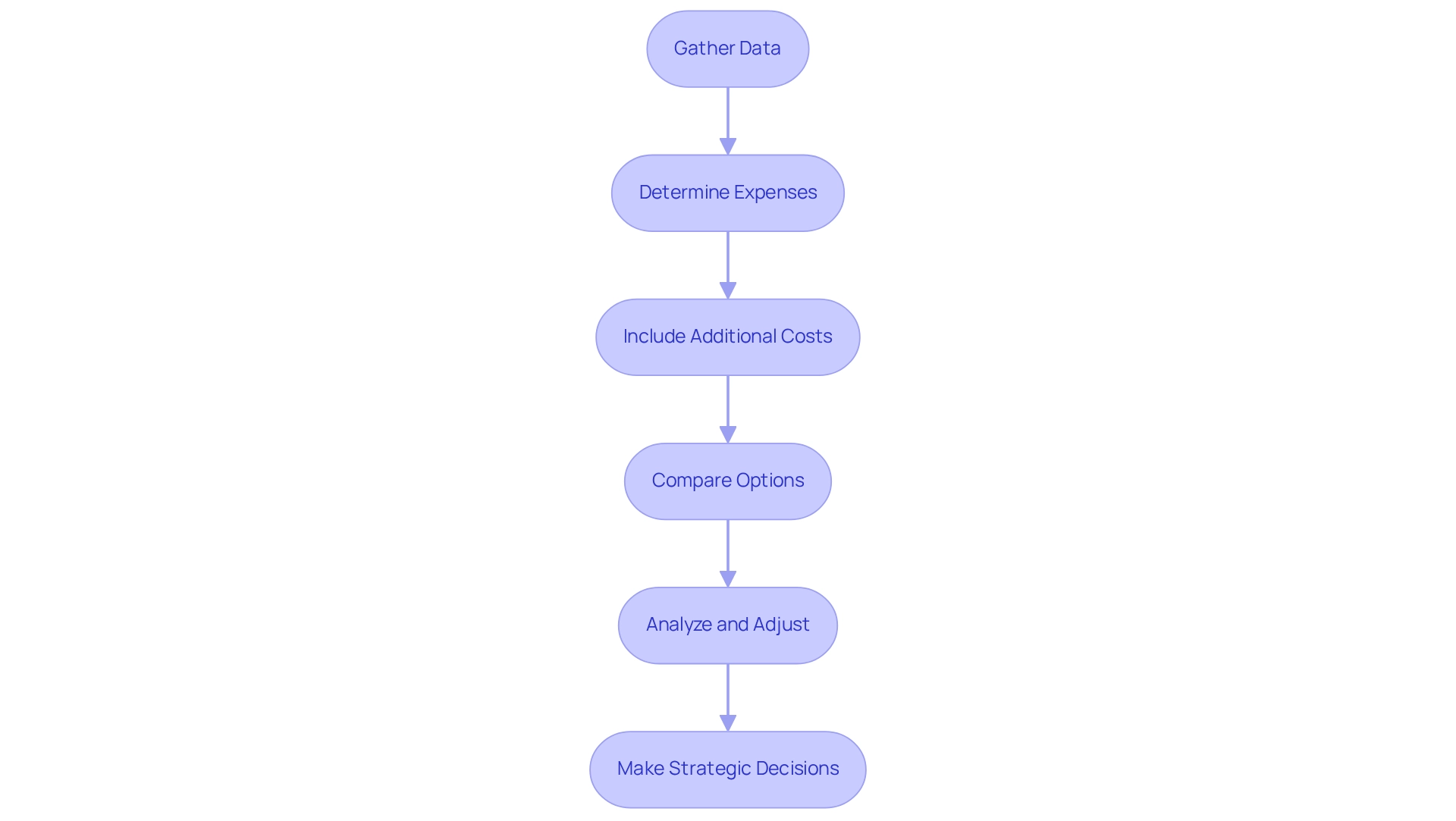Overview
The cost of medical transcription can be a significant concern for healthcare providers, especially when considering whether to perform the service in-house or outsource it. Factors such as the complexity of medical terminology and the required turnaround time can create emotional strain, with average costs in the U.S. typically ranging from $0.10 to $0.50 per line. It's essential to understand these variables to alleviate some of the stress associated with budgeting.
To navigate these challenges effectively, a methodical approach to calculating expenses is crucial. Start by gathering data and determining rates that suit your practice's needs. Comparing options can empower you to make informed decisions, ensuring that you manage your budget effectively while maintaining quality patient care.
Reflect on how administrative burdens can impact your ability to focus on what truly matters—your patients. By addressing these financial concerns, you can create a more supportive environment for both your practice and those you serve. We encourage you to explore these strategies further to enhance your practice's efficiency and care quality.
Introduction
In the intricate world of healthcare, it’s crucial to recognize the profound impact that accurate and timely medical transcription has on patient care. As healthcare practices navigate the complexities of patient documentation, they often face emotional challenges related to financial planning and operational efficiency. Understanding the costs associated with transcription services is essential, as it alleviates some of these burdens.
With various factors—such as labor, technology, and turnaround times—shaping expenses, healthcare providers are left to ponder: should they invest in in-house transcription or consider outsourcing? This article explores the different components that contribute to medical transcription costs, offering insights and strategies to empower practices in making informed decisions amidst an ever-evolving landscape.
By grasping the nuances of pricing structures and examining the advantages of outsourcing, healthcare professionals can not only enhance their focus on patient care but also manage their administrative responsibilities more effectively. Together, let’s navigate this journey towards a more efficient and compassionate healthcare environment.
Understand the Basics of Medical Transcription Costs
The cost of medical transcription can raise concerns for many healthcare providers, as it is influenced by various factors such as whether the work is performed internally or outsourced, the complexity of medical terminology, and the required turnaround time. Typically, these expenses are assessed on a per line, per minute, or per hour basis. In 2025, the average cost for transcription services in the U.S. ranges from $0.10 to $0.50 per line, with lower rates available in countries like India. Hourly rates can fluctuate between $25 to $50, depending on the provider's expertise and the urgency of the service.
Moreover, the cost of comprehensive encryption for data protection stands at approximately $0.10 per line, a crucial consideration for organizations dedicated to safeguarding patient information. Understanding these pricing structures is essential for healthcare facilities to accurately forecast the cost of medical transcription and effectively manage their budgets. For example, if a practice requires 1,000 lines of text conversion, the cost of medical transcription could range from $100 to $500, depending on the provider and the complexity of the service.
Additionally, can vary significantly, with online courses costing between $300 to $2,000, while in-person programs may reach up to $10,000. This financial aspect highlights the importance of having skilled professionals in the field. As Ruthie Corbin wisely noted, "There will always be a need for humans in healthcare, and administrative assistants are a vital part of that picture."
Familiarizing yourself with these terms and current trends can empower you to navigate the financial landscape of medical documentation more effectively. It is also important to recognize the distinction between medical scribes, who document encounters in real-time, and medical transcriptionists, who transcribe recorded audio. Both roles are essential in the healthcare documentation process, and understanding their contributions can help alleviate some of the administrative burdens that impact patient care.

Identify Key Cost Components in Medical Transcription
Understanding the cost of medical transcription can be daunting for healthcare providers, especially when balancing patient care with administrative responsibilities. Here are some key components to consider:
- Labor Costs: Often, this represents the largest expense, whether you’re hiring in-house transcriptionists or contracting with an external provider. In-house transcriptionists typically earn between $10 to $15 per hour, while outsourced services may charge per line or minute. It's essential to recognize that the median salary for secretaries and administrative assistants is around $47,460, highlighting the financial implications for organizations weighing the decision to hire versus outsource.
- Technology Costs: This includes the necessary software and hardware for recording. Many practices invest in specialized recording software, which can range from $30 to $500 annually. As we approach 2025, it’s vital to have resilient systems that can meet the demands of modern healthcare.
- Quality Assurance: Ensuring accuracy in documentation may lead to additional costs for quality assessments, particularly with complex documentation requiring specialized expertise. How often do you find yourself facing the challenge of maintaining quality while managing costs?
- requests often come with higher fees. Understanding how turnaround times affect pricing can empower practices to manage expenses more effectively. Have you ever considered how a quick response might impact your overall costs?
- Volume Discounts: Many recording services offer discounts based on the volume of work. Identifying these opportunities can lead to significant savings. For instance, a neurosurgeon noted a cost of $0.11 per 65-character line for a 24-hour turnaround through a local company, illustrating the potential pricing structure within the industry.
By recognizing these key components, healthcare providers can navigate the complexities of the cost of medical transcription with greater confidence and compassion. It’s about finding the right balance that allows you to focus on what truly matters—providing excellent patient care.

Evaluate In-House vs. Outsourced Transcription Costs
When healthcare providers face the choice between in-house and outsourced transcription, several critical factors can weigh heavily on their minds:
- Cost Efficiency: At first glance, in-house documentation may appear economical. However, the cumulative costs of salaries, benefits, and necessary equipment can quickly escalate. Outsourcing, on the other hand, significantly reduces these overhead expenses, making it a more financially viable option for many practices. CosmaNeura stands out as the only company creating AI solutions for , reflecting a growing trend towards outsourcing in this sector.
- Quality and Accuracy: Outsourced transcription solutions often employ specialized professionals who bring a wealth of expertise, leading to improved accuracy rates. In-house staff may require extensive training, which adds to operational costs and can impact overall efficiency. As Athreon wisely notes, "It’s not solely about saving money; it’s about investing in a solution that provides expertise, compliance, and peace of mind, enabling healthcare professionals to concentrate on their primary goal: patient health and well-being."
- Scalability: Outsourced solutions offer the flexibility to adjust operations based on your practice's needs. This adaptability is particularly beneficial during peak periods, alleviating the stress of long-term commitments associated with hiring additional in-house staff.
- Focus on Core Activities: By outsourcing transcription tasks, healthcare providers can refocus their attention on patient care rather than administrative duties. This shift not only enhances the delivery of care but also boosts patient satisfaction and outcomes.
- Turnaround Times: The efficiency of outsourced services often results in quicker turnaround times, which is essential for maintaining workflow in busy practices. Rapid processing of documentation can lead to and operational efficiency.
As we look ahead to 2025, the landscape of medical documentation continues to evolve, with outsourcing emerging as a strategic choice for many healthcare providers. The combination of savings, enhanced accuracy, and the ability to concentrate on core healthcare activities makes outsourcing an appealing option in the current market. As the healthcare sector increasingly acknowledges the value of specialized services, the trend towards outsourcing medical documentation is likely to grow, reflecting a broader commitment to operational efficiency and quality care. Moreover, case studies from different sectors, such as law firms exploring outsourcing for efficiency and expense reduction, illustrate the advantages of this method, rendering it an attractive choice for healthcare providers.
In navigating these challenges, consider how outsourcing could alleviate some of the burdens you face, allowing you to focus more on what truly matters—your patients.
Calculate Your Practice's Medical Transcription Costs
To accurately calculate the cost of medical transcription for your practice, it's essential to approach this task with care and understanding. Many healthcare providers face the emotional burden of managing administrative tasks, which can detract from patient care. By following these steps, you can alleviate some of that stress and gain clarity on your expenses.
- Gather Data: Start by collecting essential information, such as the number of patient encounters needing documentation, the average length of dictation, and your current method of transcription.
- Determine Expenses: Calculate the charge per line or minute based on your current provider's rates. For instance, if your provider charges $0.10 per line and you handle 1,000 lines each month, your total cost would be $100. This simple calculation can help you understand your financial commitments better.
- Include Additional Costs: Remember to factor in supplementary expenses like software subscriptions, quality assurance measures, and potential overtime for urgent typing requests. These additional costs can add up, and being aware of them is crucial for effective budgeting.
- Compare Options: If you're considering outsourcing, gather quotes from multiple transcription services. This will allow you to evaluate their prices against your current expenditures, ensuring you make a well-informed choice. Keep in mind that may be more affordable for simple projects, but it might lack flexibility for varying workloads.
- Analyze and Adjust: Regularly review your calculations to identify trends and adjust your budget as necessary. This continuous evaluation is vital for efficient expense management and maintaining the financial well-being of your practice.
By following these steps, healthcare providers can gain a clearer understanding of the cost of medical transcription, which enables them to make strategic decisions that enhance operational efficiency and financial sustainability. Additionally, remember that it is often quicker to skim through a written document than to listen to an audio recording, saving precious time for healthcare workers. Clarity in billing methods is crucial; consider services like Ditto that emphasize straightforward pricing. Furthermore, obtaining certification for transcriptionists can enhance their career prospects and demonstrate a commitment to high standards in medical documentation. As one neurosurgeon noted, "cents a line. No other charges," underscoring the importance of straightforward billing practices.

Conclusion
Understanding the complexities of medical transcription costs can feel overwhelming for healthcare providers dedicated to operational efficiency and improved patient care. Have you ever considered how these costs affect your ability to deliver exceptional care? This article has outlined the key factors influencing transcription expenses—labor, technology, quality assurance, and turnaround times. By recognizing how these components interact, practices can better anticipate their costs and make informed financial decisions.
The choice between in-house and outsourced transcription services brings significant implications for both cost and quality. While in-house transcription may initially appear cost-effective, hidden expenses related to salaries, training, and technology can accumulate quickly. In contrast, outsourcing not only offers potential savings but also grants access to specialized expertise that enhances accuracy and efficiency. As the healthcare sector evolves, outsourcing is emerging as a strategic option, allowing providers to focus on their core mission: delivering exceptional patient care.
Ultimately, by adopting a proactive approach to understanding and managing transcription costs, healthcare practices can navigate the financial landscape more effectively. This empowers them to allocate resources wisely, ensuring they maintain high standards of documentation without compromising quality or patient outcomes. As the industry moves forward, embracing these insights will be crucial for fostering a compassionate and efficient healthcare environment.
Key Solutions to Consider:
- Evaluate the total cost of in-house versus outsourced transcription.
- Invest in technology that streamlines the transcription process.
- Prioritize quality assurance to enhance patient outcomes.
By taking these steps, you can ensure that your focus remains on what truly matters: compassionate care for your patients.




